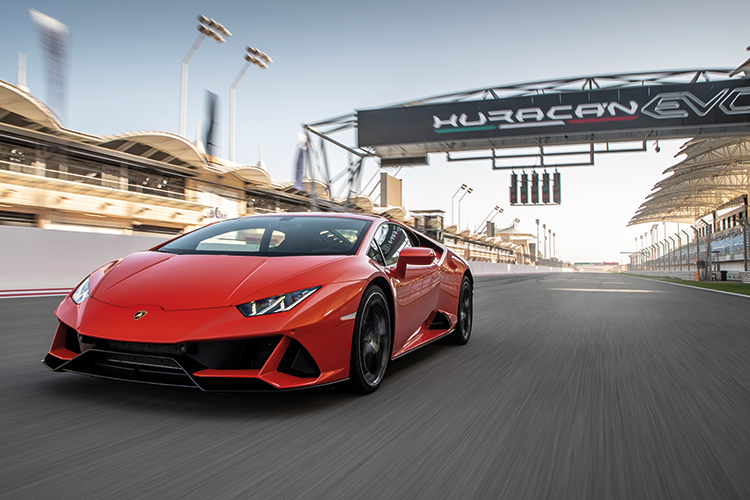
Huracan EVO’s LDVI system and more potent performance will leave rivals trailing in its wake.
The Lamborghini Huracan is nearly five years old and the only other variants are the RWD and Performante models, which come in both coupe and roadster form.
Joining this lineup is the Huracan EVO, which is considered the mid-life facelift for the model.
There are subtle but noticeable features that set the Huracan EVO apart from its predecessor.
The biggest one is the slotted rear deck lid spoiler that helps generate seven times more downforce than the standard Huracan.
A pronounced rear diffuser adds to the increased downforce.

Fighter jet-like cockpit now has an infotainment system with Apple CarPlay and an 8.4-inch touchscreen.
The quad exhaust pipes in the pre-facelift model have been reduced to just two.
Up front, the spoiler has a front splitter that reduces aerodynamic drag while increasing downforce.
Drag is lesser than the standard Huracan, but at the same time, downforce is considerably greater without the active aerodynamic system (ALA) found in the Performante.
Inside, the cockpit has been largely untouched, except for the addition of a new 8.4-inch infotainment display.
In this day and age, connectivity of a lack thereof is a deal-breaker.

So, the Huracan EVO gets Apple CarPlay with smartphone integration. Android Auto will be offered later.
Sure to excite potential owners is the EVO’s engine, which is the 640hp, naturally aspirated V10 from the Huracan Performante.
And the EVO has the same exciting soundtrack as the Performante, too, thanks to its high-flow titanium exhaust system that’s also about 10kg lighter than the unit in the Huracan.
But the Huracan EVO isn’t just about enhanced power and aerodynamics.
It is really about honing the drivetrain and package, so that it becomes “friendlier” to normal drivers.

In comparison, the Huracan Performante requires an expert hand to get the best out of it.
Though both cars use the same 640hp V10, the EVO’s gentler throttle mapping ensures that it doesn’t feel like an animal straining at its leash.
The EVO’s straight-line performance is the same as the Performante, with both cars rocketing from rest to 100km/h in 2.9 seconds and having a top speed of over 325km/h.
However, the EVO is not going to beat its sibling in terms of lap times, because it does not have the same levels of downforce.
The EVO is equipped with Lamborghini Dinamica Veicolo Integrata (LDVI), the “brain” that controls the car’s dynamic systems and set-up while anticipating the next move of the driver.

One of the systems controlled by LDVI is version 2.0 of Lamborghini Piattaforma Inerziale (LPI), a suite of performance-monitoring gyros and sensors.
LPI monitors lateral, longitudinal and vertical accelerations, along with the pitch, yaw and roll rates.
Also updated are the magnetorheological suspension, traction control and all-wheel-drive, which all respond to the inputs from the LPI and make the necessary adjustments.
There is also another new key component to the Huracan EVO’s newfound ability – rear-wheel-steering.
This gives the Huracan EVO far greater agility and steering sharpness without the ride penalty that comes with stiffer springs.

LDVI’s ability to predict and react to driver inputs will make even regular pilots feel like heroes.
It also gains the stability at speed that comes from a much longer wheelbase, without actually being any longer or bigger.
The latest magnetorheological suspension has the quickest and most resolved capability on offer.
It can even apply subtle and variable damping to smoothen out road impacts mid-bump to give the impression of imperturbability.
Though I didn’t have a chance to take the Huracan EVO out on the road, I did pilot the car around an F1 track.
At the Bahrain International Circuit, I had to keep up with an instructor in an identical Huracan EVO for 12 hot laps.

This session allowed me to quickly reach and explore the outer limits of the EVO by just keeping pace with the instructor. I was also able to experience what LDVI could do.
LDVI is so seamless and organic in its application that I hardly detected it doing anything.
It just feels as if I’ve made all the right moves to correct a slide or intervene to prevent a spin.
There are three drive modes to choose from: Strada, Sport and Corsa. Strada is the default mode and provides the most pleasant drive thanks to the relatively smooth dual-clutch gearbox, but it is unsuitable for track use.
Sport and Corsa are far better suited for track use. The latter setting is a “no-nonsense” one that requires the driver to shift manually, while the stability system keeps the car as sharp and as neutral as possible for neat and quick laps.

I prefer Sport mode because it is more fun and even allows the driver to push past the car’s considerable limits to drift it.
Of course, LDVI is by no means infallible and still requires the driver to have a modicum of experience.
That said, by making the car’s capabilities more accessible to the driver, Lamborghini has made the Huracan EVO a surprisingly even far more enjoyable drive than the Performante.

Lamborghini Huracan Evo 5.2 (A)
ENGINE 5204cc, 40-valves, V10
MAX POWER 640hp at 8000rpm
MAX TORQUE 600Nm at 6500rpm
POWER TO WEIGHT 450.1hp per tonne
GEARBOX 7-speed dual-clutch with manual select
0-100KM/H 2.9 seconds
TOP SPEED 325km/h
CONSUMPTION 7.2km/L (combined)
PRICE EXCL. COE From $998,000 (after $20k VES surcharge)
Lamborghini Huracan Evo launches in Singapore for $998k without COE












